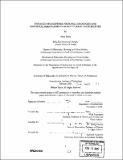| dc.contributor.advisor | Mark Jarzombek and Philip Khoury. | en_US |
| dc.contributor.author | Yahya, Maha | en_US |
| dc.contributor.other | Massachusetts Institute of Technology. Dept. of Architecture. | en_US |
| dc.date.accessioned | 2008-02-12T16:48:40Z | |
| dc.date.available | 2008-02-12T16:48:40Z | |
| dc.date.copyright | 2005 | en_US |
| dc.date.issued | 2005 | en_US |
| dc.identifier.uri | http://dspace.mit.edu/handle/1721.1/33453 | en_US |
| dc.identifier.uri | http://hdl.handle.net/1721.1/33453 | |
| dc.description | Thesis (Ph. D.)--Massachusetts Institute of Technology, Dept. of Architecture, 2005. | en_US |
| dc.description | Includes bibliographical references (v. 2, leaves 446-469). | en_US |
| dc.description.abstract | Since the commencement of post-war reconstruction in 1991, Beirut has been radically transformed through a series of large development projects that seek to reconcile the war induced fragmentation of both city and national identity whilst reclaiming its "historic" position as one of a global network of cities. These changes are grounded in a series of historiographic approaches to memory, architecture, and urbanism. This dissertation argues that a critical approach to the city in this context has to come to terms with the omissions that constitute its history and the ambiguities of its multiple political locations. It contends that these ambiguities are grounded in two specific events unleashed by the historic transition of Beirut from a thriving cosmopolitan port city and capital of an Ottoman province carrying its own name and spanning over a vast territory into the capital of a smaller new nation state under French mandate (1888-1943). The first is the ambivalence that characterized the projection and formation of national identity under mandate (as opposed to colonial) rule and the second is the superimposition of a capital city on the site of a cosmopolitan port city during this same period. | en_US |
| dc.description.abstract | (cont.) This overlap between the messy cosmopolitanism of the port city, with its own antithesis, the universalism associated with modernism in the capital city generated a condition of architectural and urban impossibility that continues to haunt its making. ased on a diverse body of primary imperial, colonial and local archival research, 19th and 20th century literature and memoirs, travelogues and visual material such as photographs, post cards and maps, as well as the insights of recent work on orientalism, colonialism, nationalism this study offers the first critical examination of the connections between political change and modern architectural-urban production in Beirut. | en_US |
| dc.description.statementofresponsibility | by Maha Yahya. | en_US |
| dc.format.extent | 2 v. (469 leaves) | en_US |
| dc.language.iso | eng | en_US |
| dc.publisher | Massachusetts Institute of Technology | en_US |
| dc.rights | M.I.T. theses are protected by copyright. They may be viewed from this source for any purpose, but reproduction or distribution in any format is prohibited without written permission. See provided URL for inquiries about permission. | en_US |
| dc.rights.uri | http://dspace.mit.edu/handle/1721.1/33453 | en_US |
| dc.rights.uri | http://dspace.mit.edu/handle/1721.1/7582 | |
| dc.subject | Architecture. | en_US |
| dc.title | Unnamed modernisms : national ideologies and historical imaginaries in Beirut's urban architecture | en_US |
| dc.title.alternative | National ideologies and historical imaginaries in Beirut's urban architecture | en_US |
| dc.type | Thesis | en_US |
| dc.description.degree | Ph.D. | en_US |
| dc.contributor.department | Massachusetts Institute of Technology. Department of Architecture | |
| dc.identifier.oclc | 62948207 | en_US |
